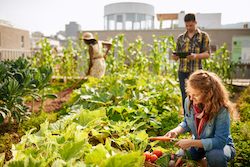‘The best place for my surplus food is in your stomach’ – But how to make that saying work?
From community gardens to restaurants and cafes using out-of-date food to create meals that are charged on a voluntary basis, food-sharing initiatives are gaining momentum. But little is known about the cumulative nature of these urban food initiatives at a city, nation or aggregate level as large, comparative analyses are rarely developed. This means that the full range and consequence of diverse food initiatives remain largely invisible to city governors, populations and to the growing communities of practice in the urban food arena. SHARECITY has classified urban food sharing initiatives that use ICT to augment sharing, across 100 cities located in 43 countries. They have found that food sharing occurs not only in urban areas celebrated for being ‘smart cities’, but also in cities facing immense social, economic and environmental challenges. These initiatives have big goals, but few have the capacity to demonstrate the impacts that they seek to create. To help the networks have a greater impact, the project is plugging the data gap by collating all the information on the 3 939 initiatives it has identified and creating an online database. Publicised through a project website as well as sharing and urban networks, this online database was viewed more than 2 670 times by 1 647 unique users from 71 countries around the world – from South Korea and Mexico to Brazil and Senegal – in the first ten months following its launch. A recently published study carried out by the team looked at the way food sharing networks are performing across 100 urban areas. As the writers explain they have adopted conceptual insights from the intersection of social and economic practice-oriented approaches. The resulting food-sharing database improves our understanding of, and makes visible, the ways in which food (and food-related skills, stuff and spaces) is being shared across diverse urban settings. Their findings highlight the important role played by ICT – to be included in the database website the initiative needed to be using either a facebook page, a meet-up or twitter profile, app or platform. Although the use of websites tends to dominate, the team has found that some food sharing groups are beginning to embrace apps and interactive platforms for things like food collection and bartering. For example, Byhøst (City Harvest) Copenhagen, Denmark, uses its app to share knowledge about urban foraging and wild plants while Wild Food in the US city of Houston uses its app to share information about edible plants. The project’s mapping of urban food sharing landscapes shines a light on the ‘problem of invisibility’. This can cause a novel intervention in one area to be easily dismissed as interesting but rather inconsequential niche experiments in the face of systems dominated by multinational agri-food organisations. Ultimately, the database allows for more consistent and comparable analysis of how particular spaces, labour and skills around food are mobilised, appropriated, accessed, financed and distributed. It draws attention to the combination of technology and human committment that such initiatives embody. The ICT component in particular illustrates the extent to which people harness technology to share food. This potentially reconfigures not only the prevailing socio-economic order, but also the technical infrastructures that support it. SHARECITY (Assessing the practice and sustainability potential of city-based food sharing economies) is identifying and examining diverse practices of city-based food sharing economies. It does so by first determining their form, function and governance and then by identifying their impact and potential to reorient eating practices. For more information, please see: Project website
Countries
Ireland



